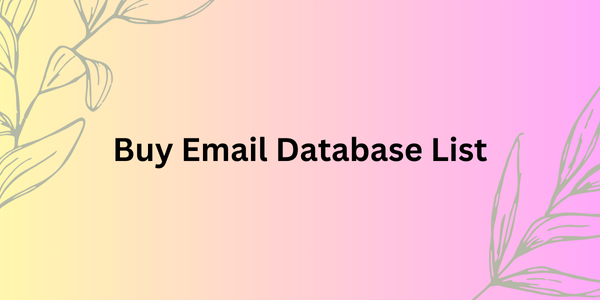Buying an email database with millions of contact leads may appear to be a rapid and effective method Buy email of getting the message out before a large audience. Still. One must tread cautiously when considering such an option. Here is what you need to know about buying email lists: possible benefits. Risks. And legalities. And alternative strategies that could serve to better engage a high-quality audience.
Why businesses consider buying email lists
Businesses tend to think of purchasing email lists as one of many Buy Email Database List shortcuts to increase their reach quickly. A list of a million-plus contacts seems like an overnight way to improve visibility. Expand marketing reach. And even drive sales leads without investing any effort in organic growth. To firms looking to accelerate their marketing effort. A bought list may seem an attractive shortcut.
Potential benefits of buying an email database
The one-million contact list would instantly provide access to a large audience and. Therefore. Can help get around those painfully slow processes for building contact over content marketing or any other organic strategy.
Less time-consuming: buying a database can obviate the need to generate leads. A bought database allows businesses to start running marketing campaigns instantly. This saves them from wasting time and not needing to implement customer acquisition strategies.
Lower cost per lead in the short run: if the purchase of an email list is low-cost. Then it may seem like an inexpensive way to contact a large number of prospects. This is especially true for those companies that rely on rapid results.
Risks and cons
In spite of all the possible benefits. Buying a contact list can create serious problems. These are the main concerns:
Legal and compliance issues: most countries have very strict regulations concerning email marketing. Such as the gdpr in europe and can-spam in the us. Which demand permission must be sought from the recipient before sending them promotional emails. Permission-less emailing may attract significant fines and penalties. For example. The general data protection regulation prescribes that fines of up to 20 million euros or 4% of global annual revenues must be imposed in serious cases. Something that would easily bring a business to its knees.
Reputation damage
unsolicited cold emails make a brand appear bad. As recipients may Philippines Email Address consider it spam. This may further lead to complaints whereby the business develops a bad reputation in the industry.
Low engagement and high bounce rates: many of the contacts on purchased lists may be outdated or disinterested in the company’s offerings. Causing high bounce rates and very few-if any-open or click-through rates. E-mail providers also monitor these metrics closely. So high bounce or complaint rates may cause the e-mails to wind up in spam folders.
Isp blacklisting: isps increasingly employ sophisticated identification of unsolicited email campaigns. Sending emails to a bought list risks getting the sender’s domain or ip blacklisted. Hence affecting not just today’s campaign but also future deliverability of emails.
Poor data quality: lists bought in bulk tend to contain old. Incorrect. And irrelevant information. This may mean the list has not been active on the email addresses and may even include spam traps-these are set up for the express purpose of catching spammers. A result can be far higher undeliverable emails. Which further lowers sender scores and reduces email deliverability.
Alternative strategies to grow your email list
But if buying a list has so many risks. What can replace buying the list? There are lots of different email list-building strategies to build a quality email list that gives better engagement and will be more enriching for long-term relationships with your future customers. These include:
Content marketing
Offer great content. Like ebooks. Whitepapers. Or guides. In return for a sign-up with an email address. This strategy is going to help in bringing in people who are really interested in your industry. Raising the possibility of better quality engagement.
Social media lead generation: interact with potential customers through social media and distribute lead magnets. Such as special reports or access to webinars. Paid ads across social media can also be a targeted way to attract quality leads who are likely to opt-in to email lists.
Web optimization: on your website
add pop-ups. Exit-intent forms. And clear calls-to-action; such will encourage signing up. Give visitors reasons to subscribe willingly through special discounts. Subscriptions for newsletters. And early access to new products.
Partner with other businesses: this involves partnering with other businesses on co-marketing campaigns or creating co-branded content that enables you to tap into a wider yet targeted audience who could have an interest in your product or service.
Run contests and giveaways
Great prizes in contests or giveaways bring in new subscribers. It is great to promote sharing on social media but make sure you use double opt-ins to ensure that people really want to subscribe.
Conclusion
While it’s extremely tempting to buy a list of a million contacts. The risks always outweigh the probable benefits. Unsolicited emails might get you into legal trouble. Will hurt your reputation. And ensure low engagement rates. Building a quality email list takes longer using organic means; however.




